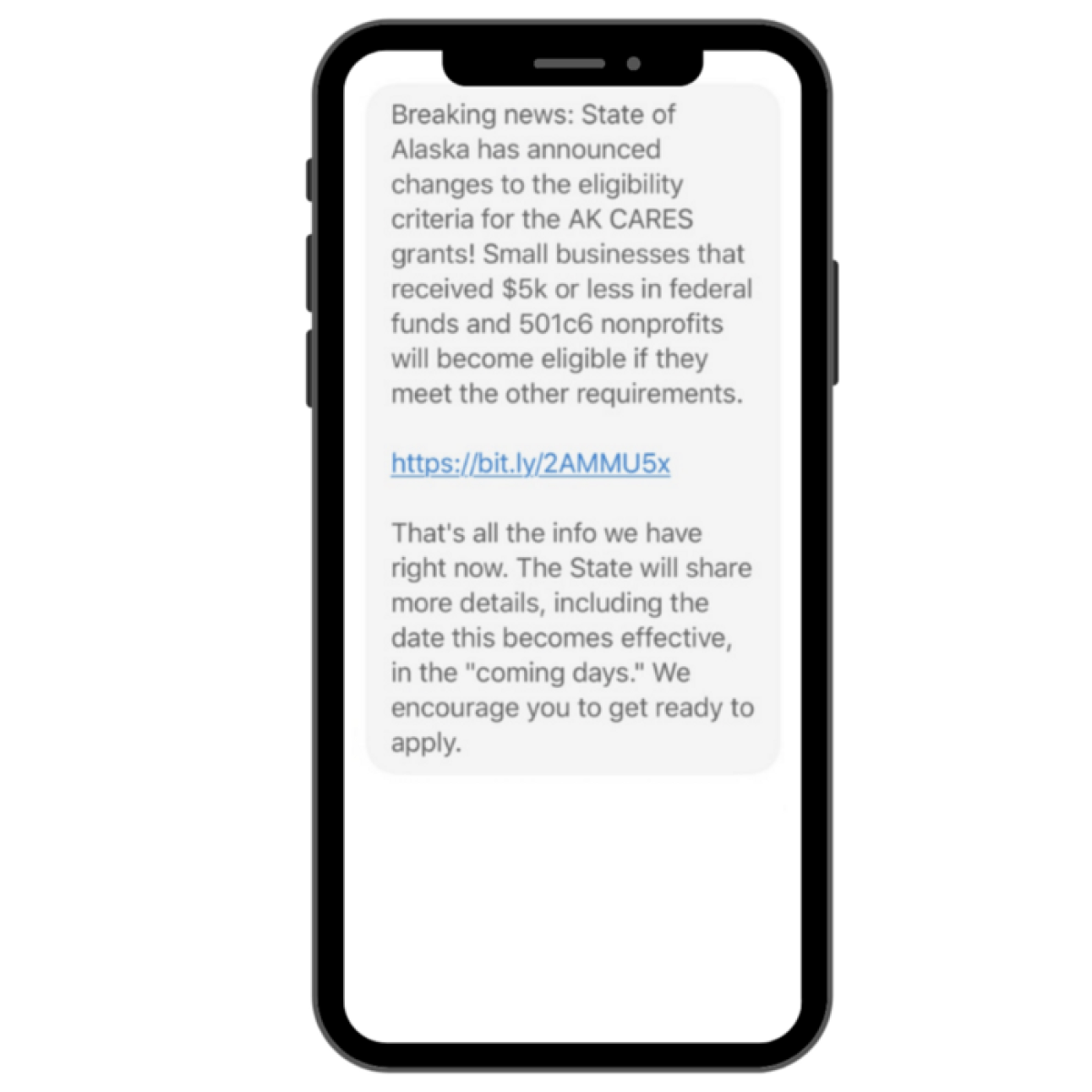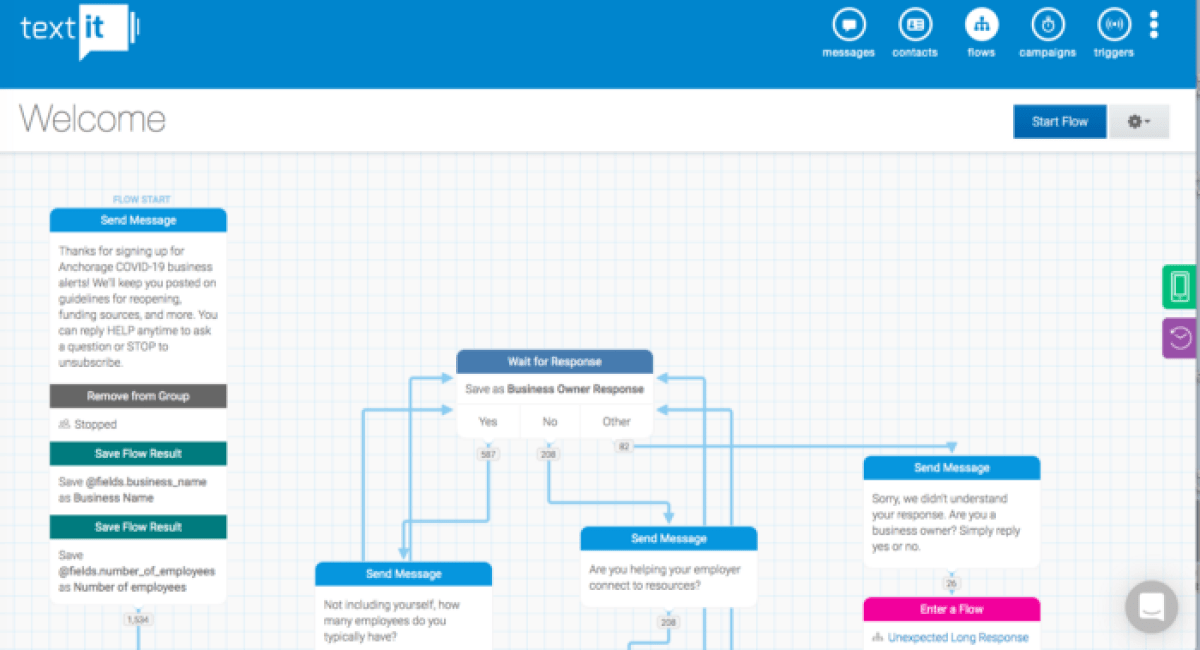Boosting small business—one text message at a time

For many small businesses struggling to survive the COVID recession, the problem is not a lack of loans and grants available from all levels of government to help them get by. The problem is knowing about them in time to have a shot at getting the funds.
That’s what city leaders in Anchorage, Alaska, found. In the early days of the pandemic, the city considered repurposing its public library staff to cold-call local business owners and proactively let them know about all the aid programs they could apply for. But relief funds were opening and closing too fast for that idea to work.
“There really wasn’t a quick way to reach businesses,” said Emily Bokar, Innovation Strategist for the Anchorage innovation team, a group funded by Bloomberg Philanthropies to help City Hall solve problems in new ways. “Our businesses were missing out on federal funds and other opportunities because they were struggling just to figure out what was going on. If you miss out on something and that happens to be a $100,000 grant — that’s huge.”
So the i-team pivoted to a more nimble approach, one that pushes out the latest information by text message. It’s a simple yet innovative tool the i-team has found success using before, and it’s now helping the city engage more than 700 people in Anchorage’s small-business community, far more than they expected to be able to reach this way.
It’s called ANC Small Biz Alerts, and here’s how it works: To subscribe, business owners text STRONG to an Alaska phone number, 907–891–7192. They’ll then get one to three updates a week on any new aid programs or reopening guidelines. If subscribers want to go deeper, they can dive into an automated sequence of text messages that Bokar likens to a “choose your own adventure” book. Whether it’s learning how to access relief funds, getting tips on how to reopen safely, or rounding up personal protective equipment, users can text back and forth to get up to speed on whatever topics they need help with, without ever interacting with a person.
Human interaction is an option, as well. Business owners with specific questions can text those in, and either Bokar or people with the i-team’s partners in the business community get back with answers. When a number of users who were having trouble figuring out a big Alaskan relief program sent in questions, Bokar and her colleagues forwarded them on to state authorities in batches to get answers turned around quickly.
[Read: How cities can use text messaging to get more residents using services]
“Lots of people in government are using text alerts,” said Brendan Babb, director of the Anchorage i-team. “What Emily has evolved this to is the next step of a tool that both alerts people to new opportunities but also provides that one-on-one help.” Bokar added that the system goes beyond the web portals many cities have set up for COVID-19 by pushing the latest information to people where they are — on their phones.
“We did a lot of tests and had conversations with business owners, and texting really was the tool they were relying on,” Bokar said. “Most of them weren’t sitting in front of a computer all day reading email, they were trying to save their businesses.”
The i-team applied a number of innovation tools and techniques to develop ANC Small Biz Alerts. Here are some of them — and city leaders interested in learning more are encouraged to text SPARK to 907–891–7192 to connect with the Anchorage i-team directly.
Collaboration. The i-team worked closely with a number of partners to develop the text-messaging tool. It’s a joint effort with Mayor Ethan Berkowitz’s Economic Resiliency Task Force, a group of business, nonprofit, and community leaders focused on charting a safe course for reopening the local economy. Other partners are the Anchorage Economic Development Corporation and a business group focused on underserved areas known as the Anchorage Community Land Trust. “This tool really was created by businesses, for businesses,” Bokar said.
Another critical partner was U.S. Digital Response, the all-volunteer army of software engineers, data analysts, marketing experts, and others who are helping state and local governments across the country with tech projects related to COVID-19 response. The group lent Anchorage an engineer who designed some of the guts of the system; a graphic designer on loan will help them create a logo and marketing tools to help promote the texting tool to businesses.
[Read: Tech volunteers ready to tackle any city’s COVID-19 challenges]
Test and learn. Rather than striving to build a perfect system at launch, the Anchorage team built it gradually, learned how people were using it, and made adjustments along the way. Before building anything in their software platform, Text It, Bokar prototyped the concept by texting people manually from her phone and pretending to be a bot. She later prototyped early versions of the more sophisticated version with actual business owners. “That was really valuable or doing something quickly and proving it could work,” she said.
There are other ways the team is using an iterative, adaptive approach. Users are asked if the information they are getting is useful to them — real-time feedback that identifies where improvements can be made. The ability for users to text specific questions to a human and get answers back is also something they rolled out gradually, in order to make sure the team could handle the volume of one-to-one requests coming in.
Data. The system gives the Anchorage team a lot of data they can use to track how engaged users are with different topics and features. For example, alerts announcing new citywide restrictions get high engagement, with more than half of all subscribers clicking through to read more. Other data comes from interviews with users, which indicate that business owners trust the text messages and that the system is reducing the stress of keeping up with things they need to know — even if it doesn’t make, say, accessing the federal Paycheck Protection Program any easier.
Research. The Anchorage team didn’t jump into a texting solution just because they believed it would work. They carefully mapped out all the assumptions they were making — like the assumption that people would want to get this kind of information on their cell phones, for example — and checked them. This involved a lot of due diligence interviews with business owners.
“I set up interviews with them and didn’t give them much information to start — I just said, ‘I’m going to test this product with you, would you sign up for something like this?’” Bokar said. Before we invested time and effort in this approach, “We wanted to hear from businesses that, yes, this is something we should be investing time in and pushing people toward.”



